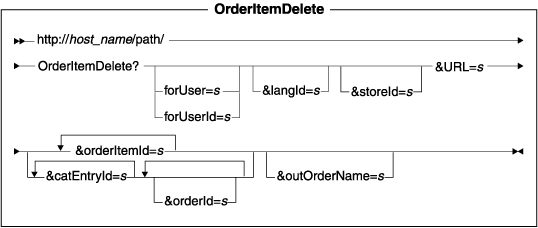Reference > Shop flow URLs > Order Management subsystem URLs > Order item URLs
OrderItemDelete URL
Delete an order item from a pending order.
URL
OrderItemDelete
Controller command
Implementation class
Commands called
URL structure
- http:// host/ path/
- The fully qualified name of the WebSphere Commerce Server and the configuration path.
 name-value pair with the &
character. For a detailed description of the parameters and their values, see the list entitled Parameter values." />
name-value pair with the &
character. For a detailed description of the parameters and their values, see the list entitled Parameter values." />
Parameter values
- forUser
- The logon ID of the user on whose behalf the command will be run; only a person with the authority to process orders can specify this parameter.
- forUserId
- Same as forUser, but identifying the user by the internal user ID, as found in the USERS table.
- langId
- Sets or resets the preferred language for the duration of the session; the supported languages for a store are found in the STORELANG table.
- storeId
- The store reference number.
- URL
- Required: The URL to be called when the command completes successfully.
- orderItemId
- Required: The reference numbers of the items to be deleted from the orders. This parameter is required only if catEntryId is not specified. This parameter can be repeated.
- catEntryId
- The catalog entry ID of the item to be deleted from the order.
- orderId
- Specifies zero or more orders, using order reference numbers or one of the special abbreviations ".", "*", ".t", "*t". See the Order abbreviations for a description of these abbreviations. If this parameter is omitted, it defaults to ".".
- outOrderName
- Specifies the name-value pairs to add to the redirection URL. The values of the added name-value pairs are the reference numbers of the input orders.
Example 1
The following example deletes the items that are associated with an order item ID of 2 from the customer's order, and then calls the OrderItemDisplay command to re-display the items in the customer's order:
http://myhostname/webapp/wcs/stores/servlet/OrderItemDelete?orderItemId=2&URL=/webapp/wcs/stores/servlet/OrderItemDisplay
Example 2
The following example deletes the items with catalog entry ID of 2 from the customer's current pending orders. The reference numbers of the current pending orders are passed to the OrderItemDisplay command using the orderId parameter.
http://myhostname/webapp/wcs/stores/servlet/OrderItemDelete?&catEntryId=2&orderId=.&outOrderName=orderId&URL=/webapp/wcs/stores/servlet/OrderItemList
Behavior
Check if the order is locked by the current CSR. If the order is not locked and called by a CSR, or if it is locked by another CSR, an exception is thrown.
Call DoInventoryActionCmd to reverse the update to the inventory for the deleted order item.
Delete the components of the order item if it is a kit or a package
Delete the order item
Call PrepareShipInfoCmd to delete the orphaned shipping information records
Call ResolveOrderItemPriceCmd to calculate the best price and update the order total
Call EventService to raise ORDERITEM_UPDATE_EVENT
If the flag calculateOrder is set:
- Call OrderCalculateCmd to re-calculate any discounts
Exception conditions
If there are no products or orders match the specified parameters, the command execution fails.
Related concepts
Related reference
Order Management subsystem URLs